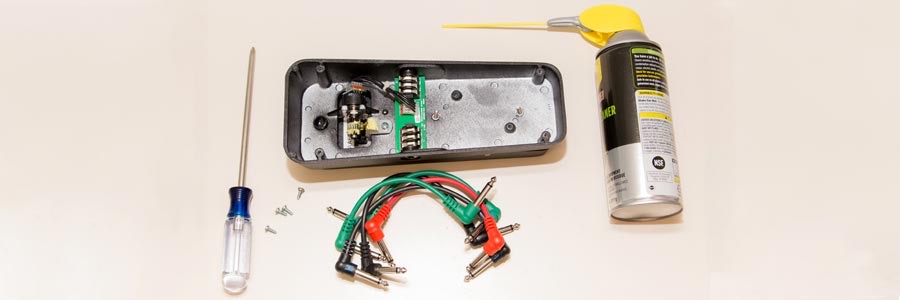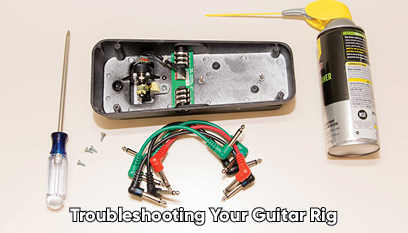 Like many players out there, I have several pedals that have been off the pedal board for some time. Honestly, it’s been about five years since my rig was at full strength. The other day I ventured downstairs, broke down the set-up I had in place, and set up my full chain. I fired up my amp with great anticipation when… nothing. Well, almost nothing. I could hear the guitar coming through the speakers, but barely. Clearly something was wrong.
Like many players out there, I have several pedals that have been off the pedal board for some time. Honestly, it’s been about five years since my rig was at full strength. The other day I ventured downstairs, broke down the set-up I had in place, and set up my full chain. I fired up my amp with great anticipation when… nothing. Well, almost nothing. I could hear the guitar coming through the speakers, but barely. Clearly something was wrong.
So, what do you do when your rig stops working? Flashback to 7th grade Science and remember the scientific method. I had recently played the scaled-down rig with no issues, so I knew that the likely culprit was one of the recently-added pedals or the cables connecting them. Thankfully I was able to quickly isolate the problem pedal and identify the issue (dirt and dust build-up). With the aid of some contact cleaner I was back up and running.
Knowing Where to Start
For the past several years I played a very simple rig. My guitar (usually a 1990s Epiphone Sheraton II) would go straight into a Boss TU-2 Tuner (which powered most of the rig via daisy chain) then into a Boss BU-2 Blues Driver before going into an Electro-Harmonix Big Muff Pi Russian, into a Boss RV-5 Digital Reverb, into a Nano LPB-1 Boost and then finally into my VOX AC-15 combo amp.
I played this simplified rig while I was serving as the lead guitar player behind a singer-songwriter who had a straight-ahead power-pop style in the vein of Social Distortion, the Replacements, and the Lemonheads. I really just needed some dirt options behind the killer breakup sound of the AC-15 (hence the Blues Driver and the Big Muff), some reverb for certain riffs and solos (since the reverb on my amp is broken and I’ve been too lazy to fix it), and a boost to cut through on solos.
Since it was a simple rig (5 pedals, 2 cables, and 4 patch cords), and it had worked fine the week before, I could reasonably deduce that the problem did not come from any of those elements. However, it’s best to be thorough.
Isolating the Problem, Part I: Get a Baseline for Testing
My first step was to verify that my two main cables (one is 10’ and the other is 20’) were both working fine. I’ve had them for over 15 years, and I know that even careful wrapping won’t protect them from the ravages of time forever.
Cable #1 was used to plug the guitar straight into the amp. No problem. OK. I knew that the amp, the guitar, and this cable were fine.
Cable #2 was swapped in. No problem. OK. Now we had a reliable test platform for locating the weak link. Of course it is possible that the issue came from one of the patch cords, but since there wasn’t any variation in the loss of signal due to motion, I figured a pedal was the likely problem.
Isolating the Problem, Part II: Introduce Some Variables
For no particular reason I decided to start with the newer pedals at the end of the chain, so the first pedal in the test environment was my Ibanez CF-7 Chorus / Flanger. I bought this pedal used after borrowing my dad’s new one. I liked its versatility as a dual pedal and found the locking knobs of the Tone-Loc system to be an interesting innovation. I have this pedal set to a light chorus tone that, when mixed with some dirt, gives a solid Nirvana / Throwing Muses kind of sound. The pedal can do much more– in addition to other reliable and desirable chorus and flanger tones, for some reason there is also a switch that goes between “normal” and “wack’d.” Don’t ask me why, because after years of messing around I can assure you that everything that comes out of this pedal in the “wack’d” mode is accurately named.
Verdict: Not guilty. Chorus was still chorusing.
Setting aside the Chorus/Flanger, we get to the reason why I don’t use the flanger settings on the CF-7: I have a Boss BF-2 Flanger. I have it set to approximate a tone what wouldn’t be out of place on the first disc of Mellon Collie and the Infinite Sadness. The opportunity to get the pedal for low money came about and I snapped it up, relegating the CF-7 to chorus only-duty. I have nothing against the flanger side of the CF-7, though.
Verdict: Not guilty. Flanger was still flanging.
The next up on the test platform was my Boss OS-2 Overdrive / Distortion. This is one of the pedals I have had since it was new. My girlfriend’s (now wife’s) mother gave it to me for my birthday about 10 years ago. Before I got my first tube amp I had the OS-2 set up to try and simulate a slightly overdriven tube amp, which was hard to do with my old amp. This is honestly a killer pedal and I’m excited to have it back in the chain. I need to find just the right spot for it in the gain structure of my rig.
Verdict: Not guilty. Overdrive was still overdriven.
Running out of options, I set up my Dunlop Limited Edition Cry Baby Wah pedal. To be honest, I’m terrible at using the wah, but damn is it fun to play! My old band in college used to end every set with a rendition of Neil Young’s “Like A Hurricane,” which would descend into chaos with wild pedal abuse and feedback. This is where most of my public wah-ing would happen. I know wah pedals are key to many players’ sounds, but I just haven’t figured out how to make it an authentic part of my tone.
Verdict: Not guilty. Although my wah tone was by no means sweet, it still wah’ed.
Sensing that I was zeroing in, I set up my Dunlop High Gain Volume pedal. As soon as I plugged the pedal in, I knew I had found the problem. Before I even rocked back the pedal I could hear the drop in signal strength. A few quick attempts as volume swells confirmed that the signal loss was coming from the volume pedal.
Verdict: Guilty on all counts.
The Solution: Contact Cleaner
Thankfully my problem came from the simplest pedal on the board. There isn’t much to a volume pedal – it’s just a metal casing and an input and output connected through a potentiometer (pot). The volume goes up or down based on the input from the player’s foot on the expression pedal. I opened up the back of the pedal and could see some dirt and dust build-up around the circuitry.
It’s somewhat ironic that the pot on the volume pedal was the problem because the main reason I own it is that my Sheraton II’s pots have almost zero subtlety to them, making it virtually impossible to do any kind of volume effect with the guitar’s built-in knobs.
I decamped to my local hardware store in search contact cleaner, an aerosol spray used to clean out the contacts between electrical components. Unfortunately, I had a devil of a time finding the stuff as it was (for some reason) stocked with the car cleaning supplies instead of the electrical gear. Just look around to a black spray can with a yellow top and you should find the WD-40 branded contact cleaner eventually.
I brought the contact cleaner home and used it as directed, and the volume pedal was as good as new. Afterwards I reassembled the entire chain and could play through with no problem at all.
If you’re reading this post because you plugged in your rig and nothing happened, I hope all you need is a little trial-and-error and some contact cleaner!

